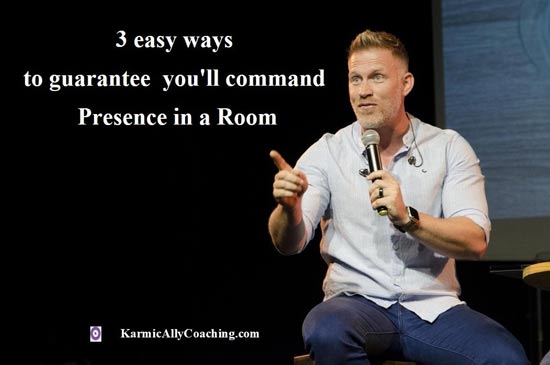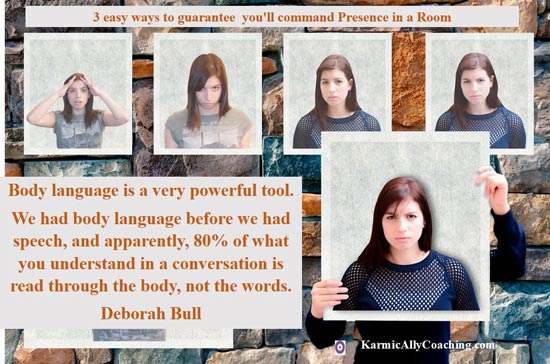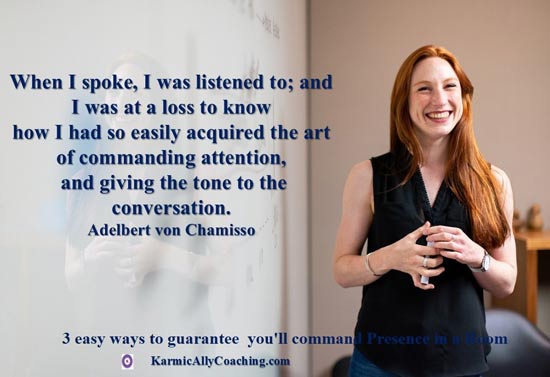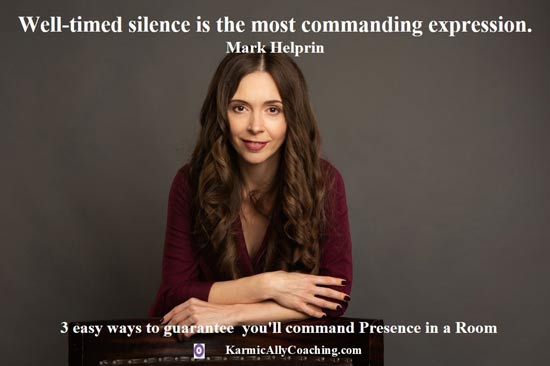This post has already been read 2138 times!

I’ve always maintained we all need to develop our own leadership style applying our power base for maximum leverage and avoid becoming authoritarian or relying solely on the power our position gives us.
While there are many skills that a good leader needs to possess, the ability to command presence in a room is a skill that can be immensely useful for anyone in a leadership position.
If you can command a room, then you can get people to listen to your instructions, you can build respect, and you can help to establish calm when there is a panicked atmosphere.
Commanding a room doesn’t mean a booming voice or high energy. It means playing to your innate strengths and knowing how to get a message across.
Many years ago I worked as the CFO of an insurance company and witnessed the transfer of Country Manager and 2 different working styles emerge.
The first Country Manager was an energetic type who would walk into the meeting room on a Monday morning full of cheer and would get us all into a high vibe mood before starting the meeting.
The other Country Manager was a quiet person in general but we knew when he had entered the room and hung to his every word contributing our ideas when required.
The thing is, both Country Managers were great leaders with different styles.
The first one was a specialist in starting regional offices in the CE & CIS region post the collapse of USSR and knew how to take his multi-cultural team with him. The second one was a sales specialist who was into strategies and then tactics.
The common factor between both was that we met our sales targets every year and were the envy of the region.
Another common factor between both men was that they stood tall, made sure they greeted everyone with a smile when they walked into the room, made eye contact while speaking to a team member and leaned forward when someone was speaking so the other person felt their opinion or idea was important.

If they could do it, we can do it too.
So how can you become a commanding presence in the room too?
You have to develop your own style.
Here are 3 ways you can do it without being noisy or creating a nuisance like the person who keeps jumping up at every point to add to the conversation simply because they want to be visible.
Use Your Body Language
In my blog post Want to be Successful? First Build Your Positive Reflex, I mentioned the results of a study done by The Center for Talent Innovation to get at the essence of executive presence and how 67% of the respondents felt Gravitas (itself a set of behaviors) was the core characteristic followed by Communication (28%).
Body language is important for both these elements of executive presence.
In another study, participants were asked to rate speakers who they thought were highly charismatic.
In almost every case, those participants rated the people who spoke with the broadest gestures and most movement as being the ones who were truly charismatic.
This is because we actually use body language for the lion’s share of our communication. Therefore, when you gesticulate and move around the room, it ensures that your body seems congruent with what you are saying.
This in turn makes you seem much more interested in what you are saying, and much more genuine in it.
At the same time, taking up more space makes you appear more confident and dominant. Moving around more will make you easier to pay attention to.
If you want to exude Executive Presence using your body, there are 2 easy techniques that I’ve seen used to good effect. One is using your eyebrows along with your eyes to convey confidence and the other is using your feet to show gravitas.
Speak From a Place of Genuine Emotion
The mistake many people will make is to try and “fake” charisma by forcing themselves to move unnaturally. Unsurprisingly, this seldom works and instead only makes you appear more insecure.
That’s why the best way to be more charismatic and to use your body language correctly, is to truly believe in what you’re saying.
Moreover, you need to really believe in what you’re saying.
One way you can do this is to tap into a powerful emotion whenever you speak.
When you think about how important, exciting, infuriating, or endearing something is, you will be able to convey that same emotion to your audience.

One non-corporate example that comes to my mind is the final scenes of the Liam Neesom movie The Grey. After surviving an air crash in Alaksa and timber wolves who have killed his co-survivors, he realizes he has literally walked into the wolves’ den and is facing the Alpha Wolf.
As he prepares for the final fight, we see his hands and expression and understand a deep emotion that doesn’t leave us even after the movie is over.
I was so affected by these last scenes I had to google it to learn more about the movie.
The power of that last scene lay in the fact that the director had asked Liam to “channel his grief” over the death of his late wife Natasha Richardson.
While I’m not in the least suggesting you recall a traumatic situation to emote at work what I am pointing out is that great communication is about transmitting emotion as much as it is about transmitting words.
Use the Power of Silence
While pacing and gesturing can get you a long way, you can also command a room with the power of silence.

Next time the office is raucous, and you want attention, try standing silently in the corner of the room with your arms crossed.
That’s a technique my 5th Grade Class Teacher Mrs. Shrivastava used to get the entire class to go into pin drop silence.
When you apply this in the workplace, it will have an unsettling impact on the team and slowly they will become silent and pay attention too.
I’ve done it in the past while conducting training sessions in huge halls by standing on the stage and simply smiling at the audience until the noise levels went down.
It takes a huge amount of presence to be able to silence a room this way, and huge confidence to do so without opening your mouth.
How do you command the room?





 I adhere to the Certified Coaches Alliance Code of Ethics and Standards. A copy is available on request.
I adhere to the Certified Coaches Alliance Code of Ethics and Standards. A copy is available on request.
 Let's Talk through the Connect Form:
Let's Talk through the Connect Form:
Great tips, Vatsala! I use emotion and enthusiasm and my voice actively. I once did a presentation and was told that I had used ethos, logos and pathos effectively, without realising it.
Awesome Vanita. You’ve just shared the perfect example of how to use emotion and voice to deliver your message. Well done.
Vatsala, you have really highlighted the best ways to be charismatic here.
You know when I started speaking publicly and giving seminars all those years back, I got great responses from the audience and that was my high. But one day, a close friend who was helping me set the room for the seminar just before it started, was hearing me practice some parts of my talk on the podium. He looked at me and said, “get rid of the podium. your hands and body language is hidden behind that podium.” Which was so true. I use my hands even normally when I speak, so it was unnatural for me to be behind a podium. Since that day, no podium for me…only me and my hands 😉 Enough to get through!
xoxo, Z~
This is a very valuable point, Zeenat, and I am grateful you shared it.Articulating using our hands and even walking on the stage can keep the audience’s attention. It’s very important to use our natural style of communication for effectively conveying our message.
Yes, it is fascinating how often stopping your natural desire to talk and just wait… yes wait… and wait just a little longer… using the SILENCE, in appropriate situations can TRANSFORM the effectiveness of the communication and the icing on the proverbial cake is as you describe very clearly is the considered use of “BODY LANGUAGE”…
Thank you, Vatsala, for sharing your blog post with me. It is great wee reminder… and one I need to be reminded to use more often.
Thank you for adding to the conversation, Gorkh. You’re right, if we can resist the natural desire to talk and wait a bit with silence, the impact of our words is stronger. I’ve seen Barack Obama and Prime Minister Modi use it to great effect during their speeches.
Me. Silent. HA! However, when I am, people notice. Seriously though, each environment is unique and I follow my intuition for navigating the surroundings. It’s easier to be myself then try to fake a non-natural role. Great article, Vatsala. Thanks for the insights!
I’m glad you enjoyed the post, Cindy. Intuition is important in reading the room and I’m grateful you raised the point.
The first time I had to speak in public as part of my job was at the front of a church on a Sunday to a full house. Talk about nervous! Then I decided that the best thing I could do was just be myself and talk to them like friends and not critics. Worked like a charm and has ever since.
In settings where we know our audience or at least have a sense of the expectations of the audience, a warm and natural friendly approach is the best way to get our message across. Thanks for sharing your experience, Barb.
I find Natural is always best. Be kind, smile, smile with your eyes, be thoughtful. Stay in your own energy. People will pay attention, and people will be engaged, people will come to you. As well as be polite and gently address others. Some people may be shy. It’s always good to read the energy of the room and again, stay in yours. Love, kindness, polite, always works even in the darkest of situations.
You’ve raised some very important points, Heather Maria. Reading the energy of the room and infusing it with our own positive energy also helps set the stage for us to convey our message to a receptive audience.
You’ve raised some very important points, Heather Maria. Reading the energy of the room and infusing it with our own positive energy also helps set the stage for us to convey our message to a receptive audience.